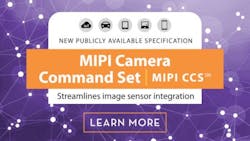New specification from MIPI Alliance streamlines integration of image sensors in mobile devices
The MIPI Alliance—a global organization that develops interfacespecifications for mobile and mobile-influenced industries—has released a new specification that provides a standardized way to integrate image sensors in mobile-connected devices.
Named MIPI Camera Command Set v1.0 (MIPI CCS v1.0), the specification defines a standard set of functionalities for implementing and controlling image sensors. This specification is offered for use with MIPI Camera Serial Interface 2 v2.0 (MIPI CSI-2 v2.0) and is now available for download. Additionally, in an effort to help standardize use of MIPI CSI-2, MIPI Alliance membership is not required to access the specification.
MIPI CSI-2, according to the alliance, is the industry’s most widely-used hardware interface for deploying camera and imaging components in mobile devices, including drones. The introduction of MIPI CCS to MIPI CSI-2 provides further interoperability and reduces integration and costs for complex imaging and vision systems, according to the alliance.
"MIPI Alliance is building on its success in the mobile camera and imaging ecosystem with MIPI CCS, a new specification that will enhance the market-enabling conveniences MIPI CSI-2 already provides," said Joel Huloux, chairman of MIPI Alliance. "The availability of MIPI CCS will help image sensor vendors promote greater adoption of their technologies and it will help developers accelerate time-to-market with innovative designs targeting the mobile industry, connected cars, the Internet of Things, AR/VR and other areas."
With imaging applications becoming more sophisticated and manufacturers deploying multiple image sensors in their products, implementation becomes more complex and time consuming. MIPI CCS aims to address these issues by making it possible to craft a common software driver to configure the basic functionalities of any off-the-shelf image sensor that is compliant with MIPI CCS and MIPI CSI-2 v2.0, according to the MIPI Alliance. The specification provides a complete command set that can be used to integrate basic image sensor features, including resolution, frame rate and exposure time, as well as advanced features like phase detection auto focus, single frame HDR or fast bracketing.
"The overall advantage of MIPI CCS is that it will enable rapid integration of basic camera functionalities in plug-and-play fashion without requiring any device-specific drivers, which has been a significant pain point for developers," said Mikko Muukki, technical lead for MIPI CCS. "MIPI CCS will also give developers flexibility to customize their implementations for more advanced camera and imaging systems."
The new specification was developed for use with MIPI CSI-2 v2.0 and is backward compatible with earlier versions of the MIPI CSI-2 interface. It is implemented on either of two physical layers from MIPI Alliance: MIPI C-PHYorMIPI D-PHY.
View more information on the specification.
Share your vision-related news by contacting James Carroll, Senior Web Editor, Vision Systems Design
To receive news like this in your inbox, click here.
Join our LinkedIn group | Like us on Facebook | Follow us on Twitter
About the Author

James Carroll
Former VSD Editor James Carroll joined the team 2013. Carroll covered machine vision and imaging from numerous angles, including application stories, industry news, market updates, and new products. In addition to writing and editing articles, Carroll managed the Innovators Awards program and webcasts.
